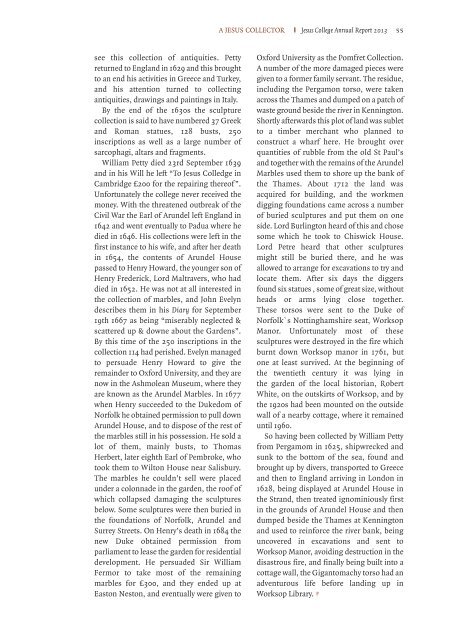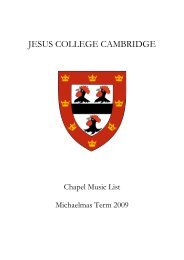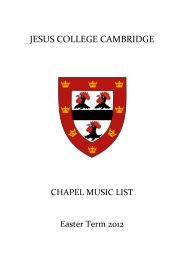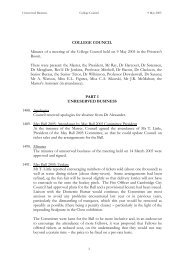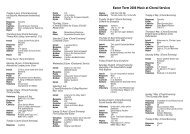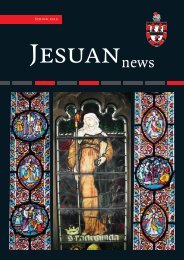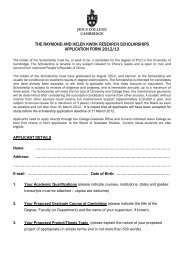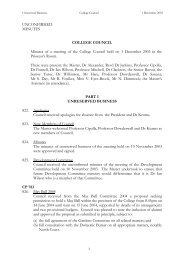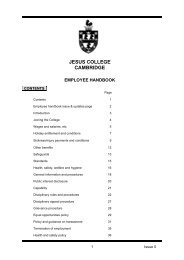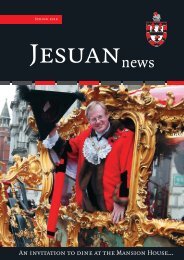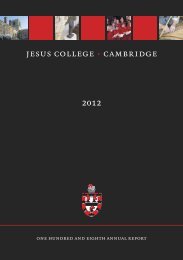2013 Annual Report - Jesus College - University of Cambridge
2013 Annual Report - Jesus College - University of Cambridge
2013 Annual Report - Jesus College - University of Cambridge
Create successful ePaper yourself
Turn your PDF publications into a flip-book with our unique Google optimized e-Paper software.
A JESUS COLLECTOR I <strong>Jesus</strong> <strong>College</strong> <strong>Annual</strong> <strong>Report</strong> <strong>2013</strong> 55<br />
see this collection <strong>of</strong> antiquities. Petty<br />
returned to England in 1629 and this brought<br />
to an end his activities in Greece and Turkey,<br />
and his attention turned to collecting<br />
antiquities, drawings and paintings in Italy.<br />
By the end <strong>of</strong> the 1630s the sculpture<br />
collection is said to have numbered 37 Greek<br />
and Roman statues, 128 busts, 250<br />
inscriptions as well as a large number <strong>of</strong><br />
sarcophagi, altars and fragments.<br />
William Petty died 23rd September 1639<br />
and in his Will he left “To <strong>Jesus</strong> Colledge in<br />
<strong>Cambridge</strong> £200 for the repairing there<strong>of</strong> ”.<br />
Unfortunately the college never received the<br />
money. With the threatened outbreak <strong>of</strong> the<br />
Civil War the Earl <strong>of</strong> Arundel left England in<br />
1642 and went eventually to Padua where he<br />
died in 1646. His collections were left in the<br />
first instance to his wife, and after her death<br />
in 1654, the contents <strong>of</strong> Arundel House<br />
passed to Henry Howard, the younger son <strong>of</strong><br />
Henry Frederick, Lord Maltravers, who had<br />
died in 1652. He was not at all interested in<br />
the collection <strong>of</strong> marbles, and John Evelyn<br />
describes them in his Diary for September<br />
19th 1667 as being “miserably neglected &<br />
scattered up & downe about the Gardens”.<br />
By this time <strong>of</strong> the 250 inscriptions in the<br />
collection 114 had perished. Evelyn managed<br />
to persuade Henry Howard to give the<br />
remainder to Oxford <strong>University</strong>, and they are<br />
now in the Ashmolean Museum, where they<br />
are known as the Arundel Marbles. In 1677<br />
when Henry succeeded to the Dukedom <strong>of</strong><br />
Norfolk he obtained permission to pull down<br />
Arundel House, and to dispose <strong>of</strong> the rest <strong>of</strong><br />
the marbles still in his possession. He sold a<br />
lot <strong>of</strong> them, mainly busts, to Thomas<br />
Herbert, later eighth Earl <strong>of</strong> Pembroke, who<br />
took them to Wilton House near Salisbury.<br />
The marbles he couldn’t sell were placed<br />
under a colonnade in the garden, the ro<strong>of</strong> <strong>of</strong><br />
which collapsed damaging the sculptures<br />
below. Some sculptures were then buried in<br />
the foundations <strong>of</strong> Norfolk, Arundel and<br />
Surrey Streets. On Henry’s death in 1684 the<br />
new Duke obtained permission from<br />
parliament to lease the garden for residential<br />
development. He persuaded Sir William<br />
Fermor to take most <strong>of</strong> the remaining<br />
marbles for £300, and they ended up at<br />
Easton Neston, and eventually were given to<br />
Oxford <strong>University</strong> as the Pomfret Collection.<br />
A number <strong>of</strong> the more damaged pieces were<br />
given to a former family servant. The residue,<br />
including the Pergamon torso, were taken<br />
across the Thames and dumped on a patch <strong>of</strong><br />
waste ground beside the river in Kennington.<br />
Shortly afterwards this plot <strong>of</strong> land was sublet<br />
to a timber merchant who planned to<br />
construct a wharf here. He brought over<br />
quantities <strong>of</strong> rubble from the old St Paul’s<br />
and together with the remains <strong>of</strong> the Arundel<br />
Marbles used them to shore up the bank <strong>of</strong><br />
the Thames. About 1712 the land was<br />
acquired for building, and the workmen<br />
digging foundations came across a number<br />
<strong>of</strong> buried sculptures and put them on one<br />
side. Lord Burlington heard <strong>of</strong> this and chose<br />
some which he took to Chiswick House.<br />
Lord Petre heard that other sculptures<br />
might still be buried there, and he was<br />
allowed to arrange for excavations to try and<br />
locate them. After six days the diggers<br />
found six statues , some <strong>of</strong> great size, without<br />
heads or arms lying close together.<br />
These torsos were sent to the Duke <strong>of</strong><br />
Norfolk`s Nottinghamshire seat, Worksop<br />
Manor. Unfortunately most <strong>of</strong> these<br />
sculptures were destroyed in the fire which<br />
burnt down Worksop manor in 1761, but<br />
one at least survived. At the beginning <strong>of</strong><br />
the twentieth century it was lying in<br />
the garden <strong>of</strong> the local historian, Robert<br />
White, on the outskirts <strong>of</strong> Worksop, and by<br />
the 1920s had been mounted on the outside<br />
wall <strong>of</strong> a nearby cottage, where it remained<br />
until 1960.<br />
So having been collected by William Petty<br />
from Pergamom in 1625, shipwrecked and<br />
sunk to the bottom <strong>of</strong> the sea, found and<br />
brought up by divers, transported to Greece<br />
and then to England arriving in London in<br />
1628, being displayed at Arundel House in<br />
the Strand, then treated ignominiously first<br />
in the grounds <strong>of</strong> Arundel House and then<br />
dumped beside the Thames at Kennington<br />
and used to reinforce the river bank, being<br />
uncovered in excavations and sent to<br />
Worksop Manor, avoiding destruction in the<br />
disastrous fire, and finally being built into a<br />
cottage wall, the Gigantomachy torso had an<br />
adventurous life before landing up in<br />
Worksop Library.


